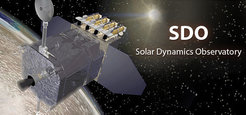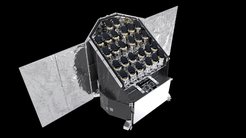
Solar and Stellar Interiors
Research tools: Helioseismology and Asteroseismology
One of the most important unsolved problems in solar physics today is the origin of the Sun’s eleven-year magnetic cycle. More generally, activity cycles in cool stars with convective envelopes are not understood. These cycles are expected to be the result of the interplay between flows (e.g., rotation, meridional circulation, convection) and magnetic fields and are described by dynamo models. It is not clear, however, how and where the dynamos operate, and what sets the amplitudes and periods of activity cycles. The reason for this lack of understanding is the absence of sufficient empirical information about subsurface dynamics in solar and stellar interiors.
Helioseismology is the use of solar oscillations as probes of the interior of the Sun. Asteroseismology is a generalization of helioseismology to the study of oscillations of other stars. These tools allow us to test and refine the theory of stellar structure and evolution and to study thermal structures and flows in the interior of the Sun and stars, thereby bringing us closer to understanding internal transport mechanisms and large-scale magnetism. Further, asteroseismology allows us to place the Sun in the context of other similar stars and to study the possible futures and pasts of the Sun.
The department "Solar and Stellar Interiors" was created in April 2011. The department is a joint initiative of the Max Planck Society, the University of Göttingen, and the state of Niedersachsen. The research of the department is driven by space-based observations, primarily from the Solar Dynamics Observatory (SDO) and Kepler. The observations are interpreted using models, including solar and stellar structure models, helioseismic forward and inverse computations, simulations of solar magnetoconvection, and flux transport dynamo models.
Sun

High-resolution and full-disk data for helioseismology are currently available from the SOHO and SDO missions and from the GONG network. The SDO/HMI helioseismic data, which automatically stream to MPS from Stanford University, play a central role in the activities of the Solar and Stellar Interiors Department as they enable us to open new windows into the solar interior, e.g. to infer global and local subsurface flows, study the global modes of rotating convection, or characterize the emergence of magnetic activity. The department is a major player in helioseismology; Essentially all aspects of research in helioseismology are addressed by the department. Two major discoveries have been made in the last years: the discovery of solar Rossby waves and the inference of the meridional flow structure in the solar convection zone. Also, in important papers, Schunker et al. (2018) and Böning et al. (2019) raised doubts about the detection of solar gravity modes by Fossat et al. (2017). Since 2019, we are involved in the ERC Synergy project WholeSun together with Vasilis Archontis (St Andrews), Allan Sacha Brun (Saclay) and Mats Carlsson (Oslo), which aims at combining new-generation simulations of the solar interior and helioseismic observations to learn about the solar dynamo.
An important upcoming mission for the department is Solar Orbiter (ESA M1, launched in Feb. 2020). Solar Orbiter will have an orbit that reaches up to about 30° out of the ecliptic plane and will study the dynamics of the polar regions of the Sun for the first time. The PHI instrument on Solar Orbiter will provide the necessary data to infer plasma flows using helioseismology and feature tracking. PHI will also carry out stereoscopic observations in combination with other instruments (e.g., HMI or GONG).
Stars and Planetary Systems
Asteroseismology is now applied to a large number of stars thanks to high-precision photometric observations from the CoRoT, Kepler, and TESS spacecrafts. The department uses these data sets, together with supporting numerical models and theoretical work, to study the interiors of pulsating stars. Asteroseismology is expected to provide precise knowledge of stellar parameters (e.g., radius, mass, evolutionary stage, and rotation rate) which will have far-reaching implications for our understanding of stellar evolution and activity. One aspect of the work in the department is to build on knowledge from helioseismology to improve asteroseismic measurements and their interpretation.

The department plays an important role in the PLATO mission ( ESA M3, 2026 launch, see Figure). The PLATO mission is the next generation planetary-transit experiment; its main objective is to characterize exoplanets and their host stars in the solar neighborhood. While it builds on the heritage from CoRoT and Kepler, the major breakthrough to be achieved by PLATO will come from combining high-precision photometry, asteroseismology, and ground-based follow-up spectroscopy for many tens of thousands of cool dwarf stars. PLATO’s strong focus on bright stars is intended to discover Earth-like planets for future programs aiming at the study of planet atmospheres and the search for biomarkers. Project members in our department are working on the development of the PLATO Data Center infrastructure, which will support the calibration and analysis of the observations on the ground.



